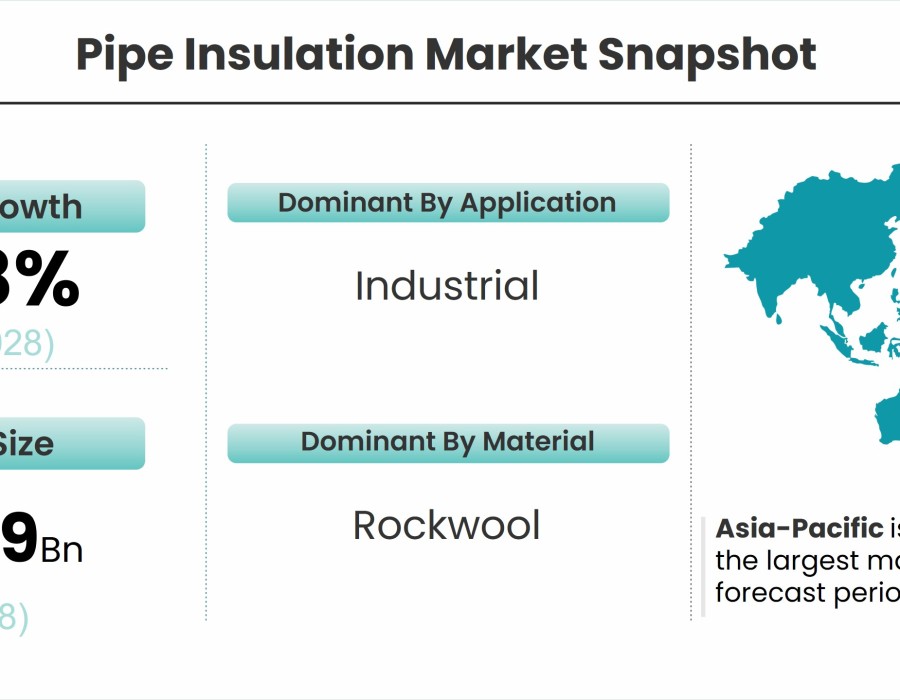According to Stratview Research, the pipe insulation market was estimated at USD 2.31 billion in 2022 and is likely to grow at a significant CAGR of 3.78% during 2023-2028 to reach USD 2.89 billion in 2028.
In the world of industrial efficiency and home comfort, the pipe insulation market plays a pivotal role in ensuring that pipelines are not just conduits for fluids but also optimized for thermal performance. This article delves into the trends shaping the pipe insulation market, exploring innovations that go beyond traditional insulation to provide efficiency, sustainability, and enhanced thermal comfort.
Efficiency Unleashed: As industries strive for energy efficiency, the pipe insulation market has witnessed a surge in demand for solutions that go beyond basic thermal protection. Advanced insulating materials and technologies are enabling pipelines to retain heat more effectively, contributing to reduced energy consumption and operational cost savings.
Smart Insulation Solutions: The integration of smart technologies in pipe insulation is a trend that's transforming the industry. Smart insulation systems utilize sensors and data analytics to monitor and regulate temperature, enabling real-time adjustments for optimal energy efficiency. This trend aligns with the broader industrial shift toward Industry 4.0.
Sustainability in Focus: Green practices are at the forefront of modern industries, and the pipe insulation market is no exception. Sustainable materials, such as recycled or bio-based insulation, are gaining traction. Manufacturers are increasingly adopting eco-friendly production processes, reflecting a commitment to reducing the environmental impact of insulation products.
Versatility in Applications: The pipe insulation market is expanding its horizons with versatile solutions catering to a diverse range of applications. From industrial settings to residential buildings, flexible and adaptable insulation materials are gaining popularity, offering tailored solutions for different types of pipes and systems.
Cold Climate Solutions: In regions with harsh winter climates, preventing heat loss from pipes is essential. Insulation designed specifically for cold climates is becoming a significant trend. These solutions not only protect pipes from freezing but also ensure consistent thermal performance in low temperatures.
Ease of Installation: With a growing emphasis on efficiency in construction and maintenance, the pipe insulation market is witnessing trends favoring easy and quick installation. Pre-cut insulation kits and user-friendly materials contribute to faster and more cost-effective insulation solutions, catering to the demands of busy industries.
Fire Resistance and Safety: Fire-resistant pipe insulation is gaining importance, especially in industries where safety is paramount. Insulation materials with enhanced fire resistance properties ensure that pipelines remain protected in the event of a fire, minimizing risks and potential damage.
Noise Reduction: Beyond thermal benefits, some insulation materials in the market are designed to reduce noise transmission through pipes. This trend is particularly relevant in residential and commercial applications, where noise reduction contributes to a more comfortable and peaceful environment.
Customized Solutions for Industry Needs: The pipe insulation market is increasingly moving towards providing customized solutions tailored to specific industry requirements. This approach ensures that insulation materials align with the unique demands of diverse sectors, from oil and gas to HVAC systems.
Conclusion:
Wrapped in comfort, the trends in the pipe insulation market reflect a dynamic industry responding to the evolving needs of both industrial and residential consumers. From advanced thermal efficiency to sustainability initiatives and versatile applications, the market is continuously innovating to provide solutions that go beyond basic insulation. As industries seek to enhance efficiency, reduce environmental impact, and ensure safety, the pipe insulation market stands as a key player in promoting comfort, sustainability, and operational excellence.






Comments